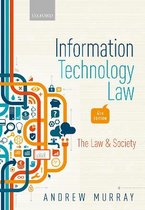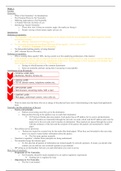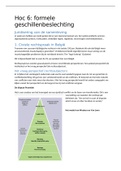Lecture:
Overview:
- What is Net Neutrality? An Introduction
- The Potential Threat to Net Neutrality
- Differing Approaches to Net Neutrality
- A Neutral Network: the Role of Law
- Introducing ‘Search Neutrality’
o Those who view it from an economic angle- the market as fixing it
o People viewing it from human rights- privacy etc
Introduction:
Defining net neutrality:
- ‘Net Neutrality is the principle that data packets on the internet should be moved impartially without regard to content,
destination or source.’
o (Murray, Information Technology Law)
- Net Neutrality demands that broadband ISPs treat all bits equally: “a bit is a bit is a bit”.’
o (Faulhaber, Economics of Net Neutrality)
- No data packed getting priority or being demoted
- [ISP= Internet Service Provider]
Defining net neutrality:
- Who is treating them equally? ISPs- having control over the underlying architecture of the internet
- ‘‘Net neutrality is this: If I pay to connect to the Net with a certain quality of service, and you pay to connect with that or
greater quality of service, then we can communicate at that level…Net Neutrality is NOT saying that one shouldn’t pay
more money for high quality of service.’ Tim-Berners Lee
o Saying we should operate at the common demoniator
o Some net neutrality puritans saying that even paying is unacceptable
Architecture of an IP network:
• PHYSICAL LAYER (ISPs)
• Backbones, Routers, Servers etc.
• LOGICAL LAYER
• TCP/IP, domain names, telephone numbers etc.
• APPLICATION LAYER
• Web browsers, streaming media, VoIP, e-mail
• CONTENT LAYER
• Web pages, audiovisual content, voice calls etc.
- Want to make sure that those who are in charge of the physical layer aren’t discriminating at the logical and application
layer
Neutrality and the architecture of the net:
- End-to-end principle;
o Packets reconvening once they get to the destination
o Data packets flowing in the quickest way to reach their destination
TCP protocol breaks data into packets. Each packet has an IP address for its source and destination.
These IP packets are transmitted through the network via nodes which read the IP address and route the
packet on to the next node until it reaches its destination. These packets are passed through the system
with the assistance of the host and the recipient of the packet: the packets are transmitted in ‘dumb
pipes’.
- Best efforts service provision:
o ‘Packets are treated in a neutral way by the nodes (the dumb pipes). When they are forwarded to the next node,
there is no need to retain further information about the packet.
The Net treats packets neutrally.
- Question to regulator= whether these principles are being undermined.
- Net neutrality keeps the internet open.
o It’s the idea that all packets of information are treated equally by network operators. It means you decide what
content you see and use, not a network operator or government.
- ISP acting as an intermediary between you and information you want to access
Main lines of argument:
- Proponents of Net Neutrality:
o Net Neutrality should be made mandatory by an explicit regulatory requirement
Needing law to regulate the issue
- Objections to Net Neutrality:
o The Net is not neutral –
, o Traffic is already shaped and applications blocked
So, a fiction
- Issue is where the line should be drawn between good and bad network management
- Consumer behaviour/the market will prevent abuse
o Don’t need law here- the market will determine
- Question of perspective of which modality is most appropriate to secure effective management.
The potential threat to net neutrality:
Discrimination: traffic management techniques:
- Loaded term to call it discriminatory but that is what is happening with data packets
- But more neutral term= traffic management
- Blocking and filtering content and applications
- Access-tiering: Specific bandwidth reserved for enhanced /guaranteed Quality of Service
o Internet service as a finite resources- some deserving access to the best bandwidth as they are higher priority e.g.
operations conducting remotely - want to ensure the best bandwidth occurring for mid-surgery - instances where
you don’t want the connection to fail
- Throttling:
o The one we most commonly have access too
o Deliberate slowing down of transmission of data packets- end result= service connection drops or the quality is
very poor.
o If not throttling - what else?
Network at maximum capacity - traffic management decision
- Negative- taking an action to hinder data packets- but there can be positive discrimination;
o Preferential arrangements with content providers, including termination charges and Walled Gardens
Occurring frequently in the US
Big service providers getting into agreement with content providers- agreeing that content provider
data would be prioritised to others- means e.g. Netflix will be at good quality.
Not customer paying extra- but content provider asking to be prioritised
o Is this a desirable arrangement? What are the implications?
How is this happening in practice?
Discrimination: traffic management technology:
- Some more intrusive than others
- How to know which data packet is which
- Some ISPs have engaged in Deep Packet Inspection [DPI]:
o ‘Operators can tag packets for fast-lane or slow-lane treatment – or block packets altogether – based on what
they contain or which application sent them…When a network provider chooses to install DPI equipment, that
provider knowingly arms itself with the capacity to monitor and monetize the Internet in ways that threaten to
destroy Net Neutrality and the essential open nature of the Internet.’
Like opening up an envelope to see what is inside
BT was engaged in this- when it came to light, huge uproar then BT stopped.
Data privacy concerns
Examples of discrimination:
- BEREC- doing surveys to see if net neutrality is a genuine issue in the EU- looking to imperial evidence.
o Confirmed discrimination:
‘Limits on speed (throttling) of P2P file-sharing or video streaming by certain providers in France,
Greece, Lithuania, Poland and the UK
‘Blocking or charging extra for the provision of VoIP [voice over IP service e.g. Skype] services in
mobile networks by certain mobile operators in Austria, Germany, Italy, the Netherlands, Portugal and
Romania.
Other concerns raised:
- Blocking could be extended to other services, such as TV broadcasting via the Internet
- Risk that charging structures would favour big players who may afford to pay for prioritisation while new entrants would
be constrained to the slow lane.
o Who does this favour?
Those players with large market share and deep pockets- concern that in the long term, no new
competitors as they wouldn’t be able to afford prioritisation
- Consumers could have difficulty accessing the services of their choice through single internet subscription.
o Concern that you wouldn’t be able to access the whole internet with a single subscription
Rationale for traffic management:
- Argue that in some instances, entirely reasonable:
o To manage traffic during high periods of congestion by prioritising certain time-sensitive traffic.
No guidance on what it is that they would prioritise during these periods
o A potential revenue stream for an ISP (for instance, could charge fees to content providers which require more
bandwidth).
Argue that they wouldn’t be imposing additional prices to consumers
Should make content providers pay












